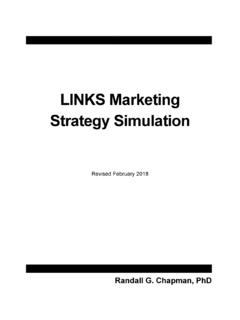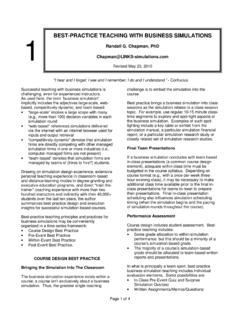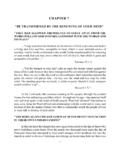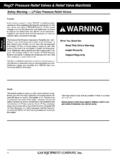Transcription of INDIVIDUAL PERFORMANCE ASSESSMENT IN …
1 Page 1 of 4 5 INDIVIDUAL PERFORMANCE ASSESSMENT in business Simulations Randall G. Chapman, PhD Revised June 30, 2018 Success doesn t come to you; you go to it. Marva Collins Consider the following (typical?) grading system for a large-scale business simulation application in an academic course: Grading Element Grading Weight Within- simulation PERFORMANCE Mid-Event Written Report Post-Event In-Class Presentation Small Larger Largest What s missing from this PERFORMANCE ASSESSMENT system? INDIVIDUAL -specific PERFORMANCE ASSESSMENT isn t part of this team-based evaluation system. Surely it s optimistic for an instructor to believe that all team members contribute equally to their business simulation team s PERFORMANCE . In large-scale business simulations, obvious PERFORMANCE ASSESSMENT elements ( , within- simulation quantitative PERFORMANCE , written reports, and in-class presentations) are team based.
2 Indeed, large-scale business simulations are meant to be team sports with all of the associated team management challenges. But, there s still a need to assess INDIVIDUAL PERFORMANCE in a business simulation team sport. Protocols suitable for evaluating INDIVIDUAL simulation participants in large-scale business simulations are presented in this LINKS White Paper. Some of the details in the following examples are specific to the author s LINKS simulations portfolio, but all can, in principle, be used in any large-scale business simulation . Since the instructor is never present for all of a simulation team s deliberations, PERFORMANCE ASSESSMENT of INDIVIDUAL participants in large-scale business simulations has to be based on some combination of: what individuals say (or write) what others say about individuals what individuals do, This organizational framework is used in the following discussion of INDIVIDUAL -specific PERFORMANCE in large-scale business simulations.
3 EVALUATION BASED ON WHAT individuals SAY What participants say via traditional INDIVIDUAL -specific writing tasks is the obvious form of INDIVIDUAL PERFORMANCE ASSESSMENT in any team-based course activity. Traditional testing and ASSESSMENT protocols exist to evaluate INDIVIDUAL PERFORMANCE in large-scale business simulations: simulation -specific examination discussion questions in-class pre-event quiz and spot simulation quiz(es) throughout a simulation event using multiple-choice questions post- simulation written assignments and memoranda ( Advice To My Successor or What I Learned Via This simulation ). Sample Discussion Questions That Might Be Included in Written Examinations The following sample discussion questions might be used in a final examination at the end of a business simulation event. Some questions are specific to the LINKS simulations, but most are relevant to all large-scale business simulations.
4 The presumption here is that the course includes a final examination and some of the final examination questions might be related to the simulation experience. Discussion Question #1: Pick any market in the simulation with which you are familiar. Page 2 of 4 Conduct and report an analysis of the value of a market share point. If you wish, you may think of this question in the context of the following scenario. By luck, magic, divine insight or intervention, or thoughtful analysis and management, you have determined that it will cost you $X to initially "buy" a 1% increase in market share ( , one market share point) and an additional $Y per simulation round will be required to maintain this newly acquired market share point. The question of interest is to compare the values of $X and $Y against the profitability of the 1% market share increment. Viewing this as an investment, determine the value of the market share point.
5 Alternatively, at least provide a delineation of a method of analysis for determining an answer to this question. Note that a quantitative, not a qualitative, analysis is required. Discussion Question #2: Consider the following statement about PERFORMANCE in the simulation : "Good management is more important than good luck." Do you agree or disagree? Why? [Hint: Provide evidence to support your point of view.] Discussion Question #3 [LINKS products simulations]: Would you be in favor of or against the elimination of patent protection in the set-top box industry? Why? Discussion Question #4: Suppose that another person joined your simulation firm now and that the simulation event was continuing for many more rounds. How would you re-allocate the responsibilities of current team members? Or, alternatively, how would you exploit the available time of this new member to the maximum possible benefit of your firm?
6 Discussion Question #5: Think about your simulation experience. Do you agree or disagree with this statement? "The ability to learn faster than your competitors is the only sustainable competitive advantage." Why? Discussion Question #6: Which research studies in the simulation are most important to your firm? Are there any research studies that aren't worth their current cost? Why? Discussion Question #7 [LINKS supply chain management simulations]: Suppose that you and all other firms in your set-top box industry had access to an additional product in your LINKS industry. Would the existence of an additional product increase, decrease, or have no impact on the use of postponed production in your set-top box industry? Why? [Hint: Explain in detail.] These discussion questions are generally complex enough so that they could be used in take-home examinations, if desired.
7 All of these questions require thoughtful analysis and discussion; they are not just simple recall questions. On occasion, I have even distributed these questions for prior study/review, and have advised students that questions such as these would be fair game for examination purposes Sample Multiple-Choice Test Question A sample LINKS multiple-choice test question follows. Instructors may access the complete LINKS Simulations Test Questions within the Instructor Resources of the LINKS website ( ). Topic: Strategy Sub-Topic: Planning and Tactics LINKS Variant(s): All Answers: 5 = = = = = In LINKS, which of the following environmental uncertainties is the most important when preparing contingency plans during your firm s forward-looking business planning efforts? (A) Uncertainty about changing customer preferences. (B) Uncertainty about market saturation and potential levels.
8 (C) Uncertainty about seasonal and cyclical trends. (D) Uncertainty about changing costs. (E) Uncertainty about competitors' activities. = = = = = Best Answer: (E) = = = = = Explanation: All of these environmental uncertainties are real and meaningful. However, competitors activities are the most difficult to predict well and the most impactful on a firm s results (LINKS firms operate in a competitive marketplace). Uncertainty about competitors activities are, therefore, the most important of (A)-(E) when preparing contingency plans in business planning efforts. Given 200+ sample multiple-choice test questions available in the LINKS simulation Test Questions test bank, a LINKS instructor can quickly and Page 3 of 4 conveniently construct suitable quizzes for use at the beginning of or throughout simulation events. Such in-class quizzes might be completed by student-pairs, to encourage additional learning opportunities that arise when pairs of students discuss such multiple-choice questions.
9 Open-book ( , open simulation manual ) multiple-choice quizzes can reduce some student angst about memorization. Of course, extensive manual consultation will use up significant time within a time-limited in-class quiz format. LINKS Memorandum Student Instructions A LINKS memorandum is a 5-page post-event memorandum on some aspect of LINKS. You're writing to your successors in this memorandum. Pick some relevant part of LINKS and pass on some advice to your successors. Be detailed and specific! You are trying to convince a LINKS novice to believe that you know what you are doing and to follow your advice. Think of this as writing one chapter in the "book of LINKS. While there may be hundreds of interesting chapters in this "book," you only have to write one of the chapters. Here's some more advice and some hints about the LINKS Memorandum: This is a 5-page single spaced memorandum (double-space between paragraphs).
10 Number all pages. Use normal margins (at least one inch on all sides of the pages) and normal font size (at least 11-point). Write a memorandum to communicate something of importance to your LINKS successors, not necessarily in the same LINKS firm or industry. Since this memorandum is designed to be of value to any LINKS participant at any time in the future, it should not contain firm- or market-specific information, except possibly by way of illustration. For example, there is no point saying that market region #1 is quite volatile (even if so in your experience), since another edition of LINKS might have different market environments. Any course-relevant topic is appropriate. Many LINKS participants have developed sophisticated spreadsheet tools for tracking, analysis, budgeting, and planning purposes. Your memo might focus on the what, why, and how of your spreadsheet tool.











